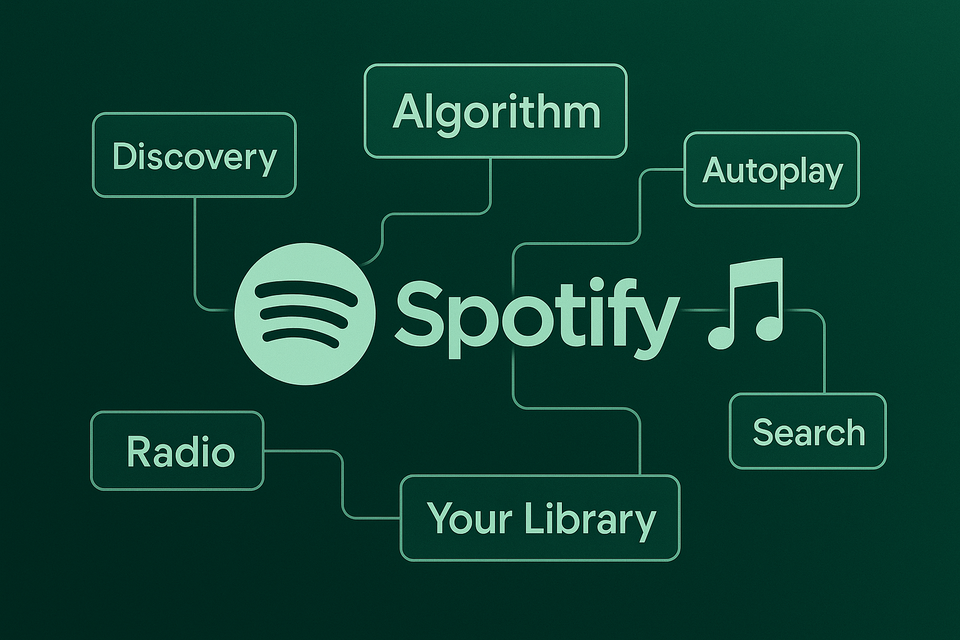Understanding Spotify in 2025: Discovery, Algorithms, and What Actually Drives Reach

🎧 Introduction
With over 600 million users and counting, Spotify is more than just a streaming service—it’s a global music discovery engine. For independent artists and labels, it’s often the first stage, the biggest challenge, and the most misunderstood part of their release strategy.
This article dives into the actual mechanics behind Spotify’s discovery system in 2025:
How are playlists selected? What does the algorithm prioritize? And how can you realistically work with the system without relying on hacks or hype?
1. The Discovery Engine: Where Listeners Find New Music
Spotify’s power lies in its ability to recommend music users didn’t search for—but end up loving.
Key discovery touchpoints:
- Home Screen (personalized tiles & mixes)
- Browse (genre-based editorials, moods, charts)
- Search (trending terms, voice input, genres)
- Radio & Autoplay (after a song ends, new suggestions roll in)
Every one of these sections is dynamically generated and personalized based on a listener’s behavior. Which means: Your song can show up anywhere—even without editorial support—if the signals are right.
2. Algorithmic Playlists: The Real Long Game
Spotify’s algorithmic playlists are powerful, scalable, and often underrated:
- Release Radar → Shows newly released music from followed artists or those with past engagement
- Discover Weekly → Songs based on listening behavior similarity
- Daily Mixes → Multiple mixes based on genres, moods, or previous sessions
- On Repeat / Repeat Rewind → Focused on listener loyalty
These are updated frequently and often outperform editorial placements in consistency and engagement.
Key factors influencing placement:
– Save rate
– Completion rate (how many listeners play the song to the end)
– Session duration after your track
– Number of followers before release
– Track metadata (genre tags, mood, context)
Algorithmic reach is earned, not granted.
3. Editorial Playlists: Opportunity, Not Entitlement
Spotify’s editorial teams are real humans—curating thousands of genre-, vibe-, and region-specific playlists.
The process is centralized via Spotify for Artists, where you can pitch one track per release at least 7 days before launch.
💡 Important: Editorial curation is contextual, not meritocratic. It’s not just about “how good” the song is—but how well it fits a specific playlist at a specific time.
Common editorial considerations:
- Is the song similar to others recently added to the list?
- Does it match the playlist’s theme or energy?
- Is the artist active and consistent?
- Are there signs of engagement already (social media, presaves, release radar response)?
And sometimes, it’s just about luck.
Don’t measure success by whether you made it onto New Music Friday.
Measure by how long your track keeps breathing.
4. How the Algorithm Learns: Behavior Over Hype
Spotify’s discovery system is data-driven and behavior-led.
What really matters:
- Saves > Likes
- Listens > Starts
- Finishes > Skips
- Replays > Reposts
- Listening context (e.g. listening while active = higher weight)
The algorithm doesn’t care about the genre as much as it cares about who else listens to this kind of thing. That’s why niche ambient producers can land on global playlists—because their audience overlaps with loyal listeners of a similar pattern.
5. Avoiding Missteps: What Not to Do
Many artists try to “game” the system—but Spotify is better than ever at detecting artificial behavior.
Common mistakes that can hurt your discovery potential:
- Paying for fake playlist placements (which leads to skip-heavy streams)
- Targeting irrelevant audiences via ads
- Over-releasing without quality control
- Ignoring your metadata (genre, mood, instruments, vocals—these tags matter!)
Spotify’s system rewards relevance and resonance—not vanity metrics.
6. How to Work With (Not Against) the System
Want your music to perform better on Spotify in 2025? Think long-term and audience-first.
Best practices:
- Use the pitch tool early—don’t leave it to chance
- Optimize your track metadata (genre, instruments, language, mood)
- Release consistently, but intentionally (weekly dumps ≠ momentum)
- Encourage active listening: social shares, Saves, Follows
- Focus on retention, not reach: it’s better to keep 5,000 fans than chase 50,000 fly-bys
Also, don’t underestimate catalog strength. Older tracks with steady engagement can become algorithmic drivers—especially when you release new music.
7. Strategic Takeaway: Spotify Is a System, Not a Strategy
Spotify is a platform—a powerful one. But it’s not a full strategy.
Building a career means using Spotify alongside other tools: YouTube, Apple, Beatport, social media, mailing lists, and direct-to-fan funnels.
Your goal is not to “beat” Spotify’s algorithm.
Your goal is to become so consistent and clear that the algorithm finds you unavoidable.
Final Thought
Spotify isn’t your enemy. It’s a tool—one with rules, rhythms, and reach. The more you understand how it works, the better you can play your part in it.
You don’t have to chase every playlist. You just have to show up where your listeners already are—and earn your place, one honest stream at a time.
Frequently Asked Questions
How do I get my music into Spotify playlists?
Submit unreleased tracks through Spotify for Artists at least 7 days before release. Focus on genre-specific playlists and provide detailed track information including mood, instruments, and similar artists. Editorial playlist placement isn't guaranteed, but proper submission increases your chances.
When does Spotify pay out streaming royalties?
Spotify pays distributors around the 15th of each month for the previous month's streams. With NexaTunes, you'll typically receive your share within 30-45 days after the streaming month ends, depending on when Spotify reports to us.
Do I need Spotify for Artists if I use a distributor?
Yes, absolutely. Spotify for Artists is free and essential for accessing your streaming data, submitting to playlists, and updating your artist profile. It works alongside your distributor - we handle the technical distribution, you manage your artist presence.
How many streams do I need to make meaningful money on Spotify?
Spotify pays roughly $0.003-0.005 per stream. To earn $100, you'd need approximately 25,000-30,000 streams. Focus on building a consistent fanbase rather than chasing viral moments for sustainable income.
View all articles about Spotify
“If you’re looking for a reliable way to distribute your music to Major Platforms , NexaTunes offers direct distribution with transparent terms. Learn more here → NexaTunes-Distribution”
NexaTunes – structured support for independent releases.
Get in touch for more information using our livechat
